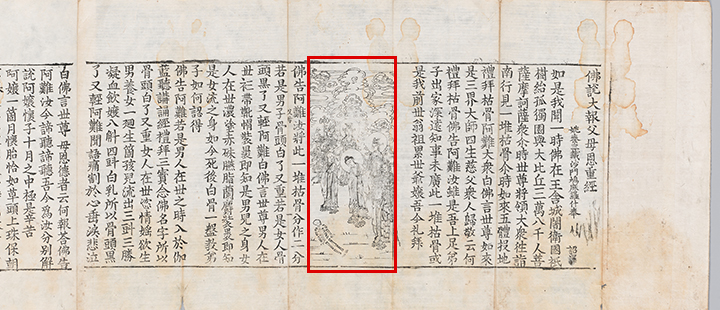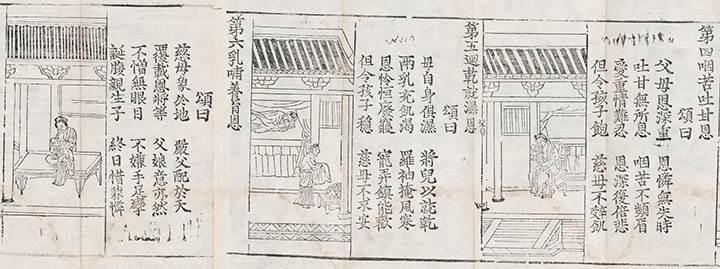Walking a path amidst billowing clouds, surrounded by disciples, Sakyamuni Buddha suddenly came to a halt. There on the ground before him was a skeleton, presumably the remains of a human. In an illustration of this scene, the Buddha stands with his hands neatly folded and his head bowed, as if in deep contemplation. What could have happened here?

Thus Have I Heard
Part of the text of the Sutra on Filial Piety (佛說大報父母恩重經) can be translated as follows:
Once, the Buddha was staying in the Jetavana Monastery in the city of Savatthi with a great assembly of 38,000 monks and bodhisattvas. Accompanied by the assembly, the Buddha headed south. While walking, he came across a pile of bones. Upon seeing the bones, the Buddha threw his body to the ground and began praying, even touching his forehead to the ground in prostration. The disciple Ananda, speaking for the rest of the assembly, asked the Buddha, “You are the great teacher of the Three Realms, and you are the merciful father of life and death. Thus, many people revere and worship you. Why did you personally pay respects to this pile of nameless bones?”
The Buddha replied, saying, “Ananda, although you are one of my chief disciples and have been ordained for a long time, your understanding is still limited. These dry bones may have been the ancestors of my previous lives or the remains of the parents of many lifetimes. That’s why I paid respects to them.”
The Buddha then instructed Ananda, “Divide this pile of dry bones into two piles. If these are the bones of a man, they will be white and heavy. If they are the bones of a woman, they will be dark and lightweight.”
Ananda spoke to the Buddha, saying, “When a man is alive, he wears big clothes, a belt, shoes, and a hat, making it easy to identify him as a man. On the other hand, women adorn themselves with red powder, rouge, and fragrances, presenting themselves as women. But after death, the bones of men and women are identical. How can we distinguish them?”
The Buddha replied to Ananda, saying, “If this was a man, while he was alive, he would have gone to the temple to hear the teachings, memorized the scriptures, paid homage to the Three Treasures of Veneration, and chanted prayers, making his bones white and heavy. But while a woman is alive, she gives birth and raises children, using her emotions and instincts. Each time she gives birth, she bleeds profusely, losing quantities of thick blood, and then feeds her children with 1000 liters of milk, causing her bones to become dark and lightweight.”
Upon hearing this, Ananda felt poignant sorrow and wept, saying to the Buddha, “How can we repay the great benevolence of our mothers?”
Depicting the Ten Maternal Benevolences
The Sutra on Filial Piety (佛說大報父母恩重經), also known as the Sutra on the Profundity of Filial Love or the Sutra on Parental Benevolence, expounds on the boundless depth of parents’ love and compassion for their children, and also teaches how we can repay their kindness. The sutra is believed to have become known in China from the middle of the Tang Dynasty to the Song Dynasty.
While it is unclear when this sutra was introduced to Korea, there are many extant editions that were produced from the late Goryeo to the late Joseon period. The oldest known edition dates back to 1378, suggesting that the sutra was likely imported during the late Goryeo period. Although the title emphasizes the importance of “parental” benevolence, its content specifically focuses on the benevolence of mothers.
This particular edition of the sutra was commissioned by Lady Kim (d. 1479), a consort of King Taejong (r. 1400–1418) of the Joseon Dynasty. As an important work that illustrates the iconography of this famous sutra and the religious beliefs of the royal court in the early Joseon period, this edition has been designated as a Treasure (formerly Treasure #1125) and is now carefully preserved at the National Museum of Korea.
The sutra lists ten “benevolences” of mothers that are deserving of reverence. The first is the benevolence of a mother who takes care of her own body during pregnancy in order to protect her unborn child. In the accompanying illustration, a pregnant mother sits in an indoor space, along with a maid. The second benevolence praises mothers for enduring the increasing pain of childbirth. The second illustration is similar to the first, except that the curtains in the room are drawn, implying that the lady of the house is near childbirth. The third benevolence is that of a mother who forgets all of her own pains and concerns after giving birth to her child. In the image, the exhausted mother lies in bed after childbirth, while two maids give the baby a bath. The remaining seven benevolences are presented in the same way, with text accompanied by an interpretive illustration.



The fourth through tenth maternal benevolences are as follows: taking bitter foods for herself while giving sweet foods to her child; giving her child a dry mat to sleep on while taking a damp mat for herself; nourishing her child with milk; washing her child to keep him or her clean; worrying about a child who is far away; being willing to do anything for her child (even sinful acts); and loving her child to the end.
The finely engraved illustrations are very clear and easy to understand. The figures are elegantly depicted with slender facial features, allowing readers to discern their expressions. Even the lines representing folds in their clothing are gracefully and intricately rendered.
Donated by Song Sung-moon
This illustrated sutra is one of the invaluable cultural properties donated to the nation by Song Sung-moon (1931–2011), an author and businessman who devoted his life to education and publication. Song Sung-moon, whose hometown is Jeongju, Pyonganbuk-do Province (present-day North Korea), was widely known as the author of English textbooks. Starting around 1960, he was deeply saddened by the fact that many invaluable historical books and records were deteriorating due to improper maintenance and storage conditions, with some even being used as wallpaper in people’s homes. Thus, he began collecting historical books, documents, and other cultural artifacts, with the dream of some day building a museum in his hometown of Jeongju, after the reunification of Korea. However, when it became clear that his dream might not be realized, he decided to donate his collection to the National Museum of Korea. Looking over the Sutra on Filial Piety, please take a moment to reflect on the noble generosity and “benevolence” of Song Sung-moon’s momentous donation.






 X
X  Facebook
Facebook 
